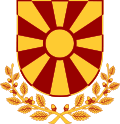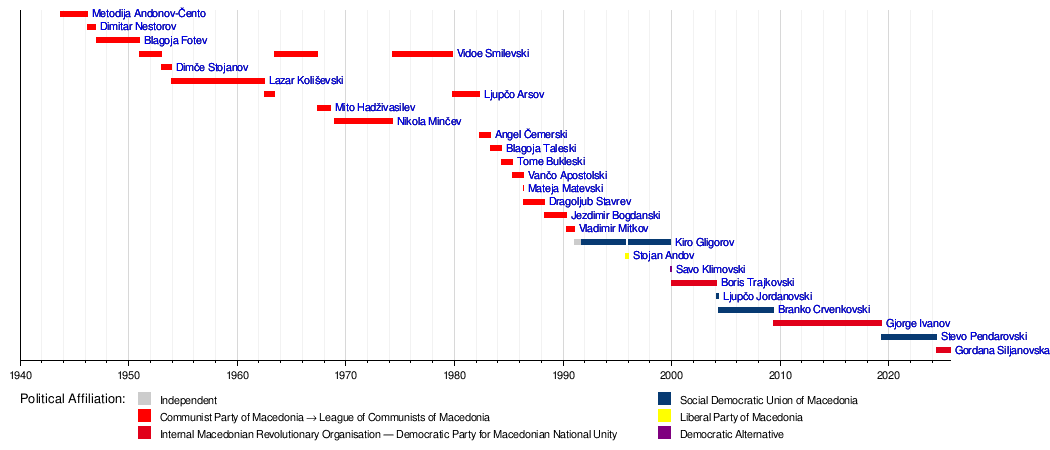President of North Macedonia facts for kids
Quick facts for kids President of the Republic of North Macedonia |
|
|---|---|

Presidential coat of arms
|
|
| Residence | Villa Vodno |
| Appointer | Direct election |
| Term length | Five years,
renewable once
|
| Constituting instrument | Constitution of North Macedonia (1991) |
| Formation | 16 April 1991 |
| First holder | Kiro Gligorov |
| Salary | 17,250 USD annually |
| Website | pretsedatel.mk |
The president of the Republic of North Macedonia is the head of state of North Macedonia. This means they are the official leader and symbol of the country. The president's title in Macedonian is Macedonian: Претседател на Република Северна Македонија and in Albanian is Albanian: Presidenti i Republikës së Maqedonisë së Veriut.
This important job was created just before North Macedonia became an independent country on September 8, 1991. The first president was Kiro Gligorov. He was the oldest political leader in Macedonia at the time.
Even though the president is the head of state, most of the government's power is held by the prime minister and the Assembly (which is like the parliament). However, the president is the leader of the armed forces. They also play a key role in how North Macedonia deals with other countries.
To become president, a person must be a citizen of North Macedonia. They also need to be over 40 years old. Plus, they must have lived in North Macedonia for at least ten of the past fifteen years before the election.
Contents
How the President is Chosen
The president of North Macedonia is chosen through a special election system. It's called a modified two-round system. Here's how it works:
First Round of Voting
A candidate can win in the first round if they get more than 50% of the votes from all registered voters. This is a high number to reach.
Second Round of Voting
If no one wins in the first round, the top two candidates go to a second round. For the result of this second round to be valid, at least 40% of registered voters must participate.
Before 2009, the rules were a bit different. The constitution used to require 50% of voters to turn out in the second round. But this rule was changed because fewer people were voting. The government worried that elections might often be canceled if not enough people voted. So, in January 2009, the rule was changed to 40%. In the 2009 Macedonian presidential election that happened after this change, about 42.6% of voters participated in the second round.
History of the Presidency
Before 1991, when North Macedonia was part of Yugoslavia, the country had a group of leaders instead of one president. This group was called a collective presidency.
Becoming an Independent Presidency
In 1990, North Macedonia changed from a socialist system to a parliamentary democracy. This meant they would have one president instead of a group. Kiro Gligorov became the first president of the Socialist Republic of Macedonia on January 27, 1991.
A few months later, on April 16, 1991, the parliament removed the word "Socialist" from the country's name. On June 7, the new name, Republic of Macedonia, became official. Kiro Gligorov continued as president under this new name.
After Yugoslavia started to break apart, the Republic of Macedonia declared full independence on September 8, 1991.
Changes in Presidential Power
When North Macedonia first became independent, the president had a lot of power. They controlled the military and were the main person in charge of foreign policy. Presidents like Gligorov and Boris Trajkovski were the main representatives of the new country abroad.
However, things changed after the 2001 Ohrid Agreement. This agreement was made to help reduce tensions between different ethnic groups in the country. As a result, new rules were added to the constitution on November 16, 2001. These changes gave more rights to the Albanian-speaking minority. They also took away some of the president's executive power.
After these changes, the prime minister became more responsible for foreign policy. Presidents like Trajkovski and Branko Crvenkovski respected this new arrangement. Over time, the president's role became more ceremonial, focusing on official duties rather than leading the government directly.
In 2009, Gjorge Ivanov became president. He was re-elected in 2014. Later, in 2016, there were protests and calls for Ivanov's impeachment due to his actions during a political crisis.
In 2019, Stevo Pendarovski became president. During a short period in 2020, when the prime minister resigned, President Pendarovski took on a more active leadership role, especially during the COVID-19 pandemic. However, when the prime minister returned, Pendarovski went back to his more ceremonial duties.
The current president is Gordana Siljanovska-Davkova. She took office on May 12, 2024.
List of Presidents
Socialist Republic of Macedonia
- Parties
KPM/SKM Independent
- Status
Acting President
| No. | Portrait | Name (Birth-Death) |
Term of office | Political party | |
|---|---|---|---|---|---|
| President of Initiatory Committee for the Anti-fascist Assembly for the National Liberation of Macedonia (ASNOM) 1943–1944 |
|||||
| 1 |  |
Metodija Andonov-Čento (1902–1957) |
1 October 1943 | 2 August 1944 | KPM |
| Chairman of the Anti-fascist Assembly for the National Liberation of Macedonia (ASNOM) 1944–1945 |
|||||
 |
Metodija Andonov-Čento (1902–1957) |
2 August 1944 | 1 January 1945 | KPM | |
| Presidents of the Presidium of the People's Assembly 1945–1953 |
|||||
 |
Metodija Andonov-Čento (1902–1957) |
1 January 1945 | 15 March 1946 | KPM | |
| — |  |
Dimitar Nestorov (1890–1968) |
16 March 1946 | 30 December 1946 | KPM |
| 2 |  |
Blagoja Fotev (1900–1993) |
1947 | 4 January 1951 | KPM |
| — |  |
Vidoe Smilevski (1915–1979) |
4 January 1951 | 1953 | KPM |
| Presidents of the People's Assembly 1953–1974 |
|||||
| 3 |  |
Dimče Stojanov (1910–1991) |
1953 | 19 December 1953 | SKM |
| 4 |  |
Lazar Koliševski (1914–2000) |
19 December 1953 | 26 June 1962 | SKM |
| 5 |  |
Ljupčo Arsov (1910–1986) |
26 June 1962 | 24 June 1963 | SKM |
| 6 |  |
Vidoe Smilevski (1915–1979) |
25 June 1963 | 12 May 1967 | SKM |
| 7 |  |
Mito Hadživasilev (1921–1968) |
12 May 1967 | 1 August 1968 | SKM |
| 8 |  |
Nikola Minčev (1915–1997) |
23 December 1968 | 6 May 1974 | SKM |
| Presidents of the Presidency 1974–1991 |
|||||
| 9 |  |
Vidoe Smilevski (1915–1979) |
6 May 1974 | 31 October 1979 | SKM |
| 10 |  |
Ljupčo Arsov (1910–1986) |
31 October 1979 | 29 April 1982 | SKM |
| 11 |  |
Angel Čemerski (1923–2005) |
29 April 1982 | 29 April 1983 | SKM |
| 12 |  |
Blagoja Taleski (1924–2001) |
29 April 1983 | 29 April 1984 | SKM |
| 13 |  |
Tome Bukleski (1921–2018) |
29 April 1984 | 26 April 1985 | SKM |
| 14 |  |
Vančo Apostolski (1925–2008) |
26 April 1985 | 28 April 1986 | SKM |
| — |  |
Mateja Matevski (1929–2018) |
28 April 1986 | 30 April 1986 | SKM |
| 15 |  |
Dragoljub Stavrev (1932–2003) |
30 April 1986 | May 1988 | SKM |
| 16 |  |
Jezdimir Bogdanski (1930–2007) |
May 1988 | 28 April 1990 | SKM |
| 17 |  |
Vladimir Mitkov (1931–2024) |
28 April 1990 | 27 January 1991 | SKM |
| 18 |  |
Kiro Gligorov (1917–2012) |
27 January 1991 | 18 September 1991 | Independent |
Republic of Macedonia / North Macedonia
- Parties
LPM DA VMRO-DPMNE SDSM Independent
- Status
Acting president
| No. | Portrait | Name (Birth-Death) |
Term of office | Political party | Election | ||
|---|---|---|---|---|---|---|---|
| Took office | Left office | Time in office | |||||
| 1 | Kiro Gligorov (1917–2012) |
18 September 1991 | 4 October 1995 | 4 years, 16 days | SDSM | 1994 | |
| – | Stojan Andov (1935–2024) Acting |
4 October 1995 | 10 January 1996 | 98 days | LPM | — | |
| (1) | Kiro Gligorov (1917–2012) |
10 January 1996 | 19 November 1999 | 3 years, 313 days | SDSM | – | |
| – | Savo Klimovski (born 1947) Acting |
19 November 1999 | 15 December 1999 | 26 days | DA | — | |
| 2 | Boris Trajkovski (1956–2004) |
15 December 1999 | 26 February 2004 † | 4 years, 73 days | VMRO-DPMNE | 1999 | |
| – | Ljupčo Jordanovski (1953–2010) Acting |
26 February 2004 | 12 May 2004 | 76 days | SDSM | — | |
| 3 | Branko Crvenkovski (born 1962) |
12 May 2004 | 12 May 2009 | 5 years | SDSM | 2004 | |
| 4 | Gjorge Ivanov (born 1960) |
12 May 2009 | 12 May 2019 | 10 years | VMRO-DPMNE | 2009 2014 |
|
| 5 | Stevo Pendarovski (born 1963) |
12 May 2019 | 12 May 2024 | 5 years | SDSM | 2019 | |
| 6 | Gordana Siljanovska-Davkova (born 1953) |
12 May 2024 | Incumbent | 1 year, 101 days | VMRO-DPMNE | 2024 | |
Timeline of Presidents

Latest Election
2024 North Macedonian presidential election
See also
 In Spanish: Presidente de Macedonia del Norte para niños
In Spanish: Presidente de Macedonia del Norte para niños
- Vice President of North Macedonia
- Prime Minister of North Macedonia
- List of presidents of the Assembly of the Republic of North Macedonia









